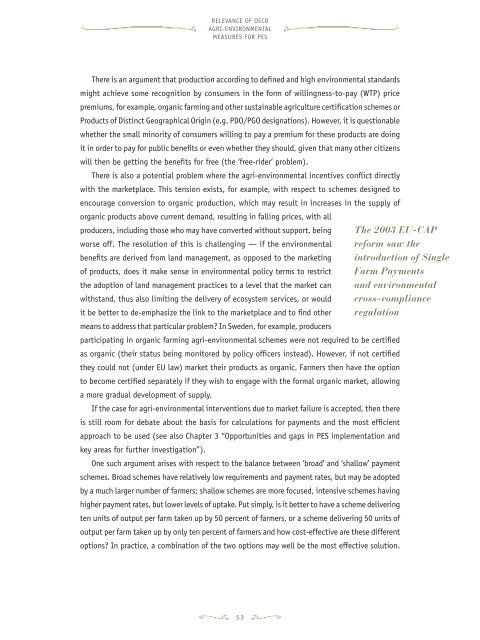agriculture and ecosystem services - Serena
agriculture and ecosystem services - Serena
agriculture and ecosystem services - Serena
You also want an ePaper? Increase the reach of your titles
YUMPU automatically turns print PDFs into web optimized ePapers that Google loves.
Relevance of OECDagri‐environmentalmeasures for PESThere is an argument that production according to defined <strong>and</strong> high environmental st<strong>and</strong>ardsmight achieve some recognition by consumers in the form of willingness-to-pay (WTP) pricepremiums, for example, organic farming <strong>and</strong> other sustainable <strong>agriculture</strong> certification schemes orProducts of Distinct Geographical Origin (e.g. PDO/PGO designations). However, it is questionablewhether the small minority of consumers willing to pay a premium for these products are doingit in order to pay for public benefits or even whether they should, given that many other citizenswill then be getting the benefits for free (the ‘free-rider’ problem).There is also a potential problem where the agri-environmental incentives conflict directlywith the marketplace. This tension exists, for example, with respect to schemes designed toencourage conversion to organic production, which may result in increases in the supply oforganic products above current dem<strong>and</strong>, resulting in falling prices, with allproducers, including those who may have converted without support, being The 2003 EU-CAPworse off. The resolution of this is challenging — if the environmental reform saw thebenefits are derived from l<strong>and</strong> management, as opposed to the marketing introduction of Singleof products, does it make sense in environmental policy terms to restrict Farm Paymentsthe adoption of l<strong>and</strong> management practices to a level that the market can <strong>and</strong> environmentalwithst<strong>and</strong>, thus also limiting the delivery of <strong>ecosystem</strong> <strong>services</strong>, or would cross‐complianceit be better to de-emphasize the link to the marketplace <strong>and</strong> to find other regulationmeans to address that particular problem? In Sweden, for example, producersparticipating in organic farming agri-environmental schemes were not required to be certifiedas organic (their status being monitored by policy officers instead). However, if not certifiedthey could not (under EU law) market their products as organic. Farmers then have the optionto become certified separately if they wish to engage with the formal organic market, allowinga more gradual development of supply.If the case for agri-environmental interventions due to market failure is accepted, then thereis still room for debate about the basis for calculations for payments <strong>and</strong> the most efficientapproach to be used (see also Chapter 3 “Opportunities <strong>and</strong> gaps in PES implementation <strong>and</strong>key areas for further investigation”).One such argument arises with respect to the balance between ‘broad’ <strong>and</strong> ‘shallow’ paymentschemes. Broad schemes have relatively low requirements <strong>and</strong> payment rates, but may be adoptedby a much larger number of farmers; shallow schemes are more focused, intensive schemes havinghigher payment rates, but lower levels of uptake. Put simply, is it better to have a scheme deliveringten units of output per farm taken up by 50 percent of farmers, or a scheme delivering 50 units ofoutput per farm taken up by only ten percent of farmers <strong>and</strong> how cost-effective are these differentoptions? In practice, a combination of the two options may well be the most effective solution.53


